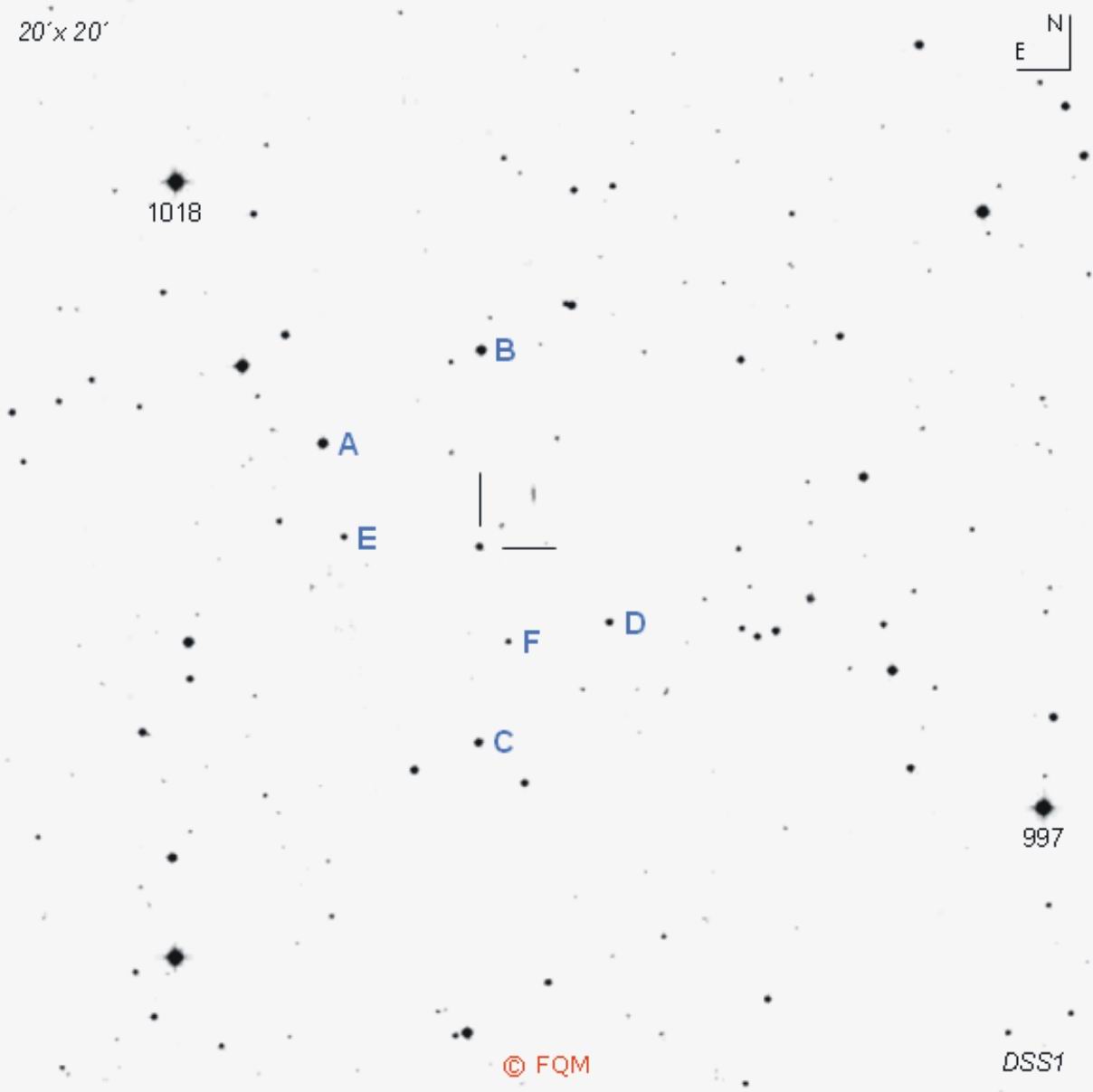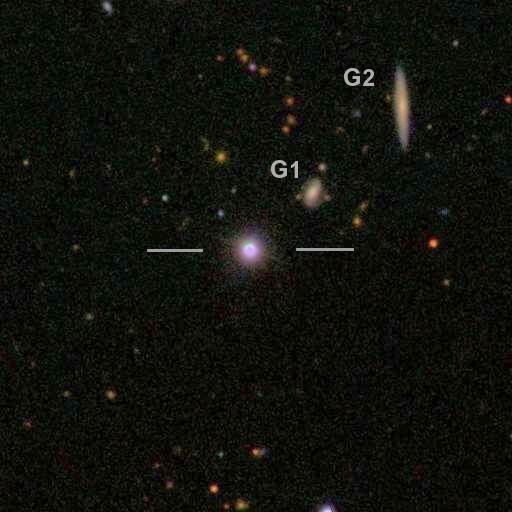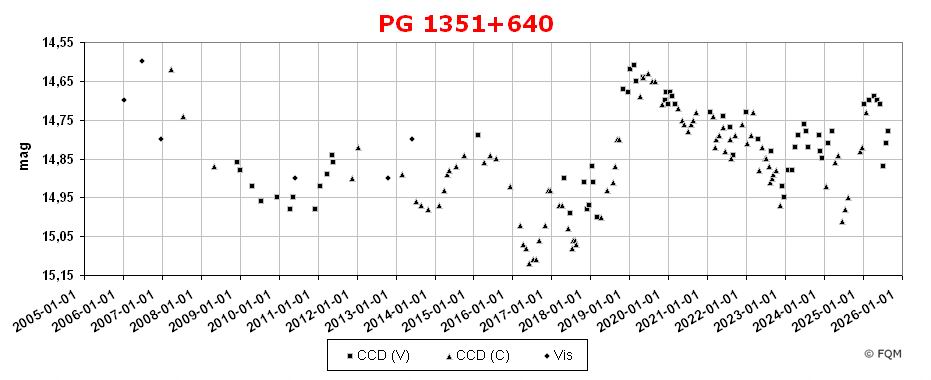
| Frankfurt Quasar Monitoring |
| PG 1351+640 |
| Cross-Identifications | 2XMM J135315.8+634546, PGC 49340, LEDA 49340 IRAS 13517+6400, SDSS J135315.83+634545.6 FBS 1351+640, QSO B1351+640, 1351+640 NVSS J135315+634545, PG 1351+64 |
| Equat. coordinates | RA 13 53 15.7 DE +63 45 46 (J2000) |
| Constellation | Draco |
| Type | QSO |
| Redshift (2) | z=0.088 |
| Distance (2) (3) | 357 Mpc |
| Total mag range (mv) (4) | 14.0 - 15.2 |
| Catalog Magnitude (1) | 14.28 |
| Absolute Magnitude (1) | -24.1 MB |
| Light Travel-Time (2) | 1.115 × 109 yrs |

Comparison stars
| star | B | V | Rc | Ic |
| A | 13.066
(0.011) |
12.652
(0.020) |
12.404
(0.017) |
11.860
(0.031) |
| B | 14.399
(0.006) |
13.192
(0.010) |
12.484
(0.001) |
11.835
(0.029) |
| C | 15.891
(0.049) |
14.388
(0.013) |
13.307
(0.004) |
12.297
(0.173) |
| D | 15.608
(0.009) |
14.716
(0.002) |
14.196
(0.004) |
13.715
(0.006) |
| E | 15.983
(0.015) |
15.319
(0.002) |
14.848
(0.008) |
14.539
(0.010) |
| F | 16.293
(0.011) |
15.756
(0.005) |
15.336
(0.007) |
14.875
(0.071) |



| PG
1351+640 is a small amplitude variable object in Draco, only 1.4° SW of
Alpha Draconis. The designation PG 1351+640 refers to the Palomar-Green
Bright Quasar
Survey (PG), where this object was discovered as a blue stellar object
in
1976. Follow-up
spectral analysis revealed a Seyfert 1-spectrum, which led to the
quasar
classification. The elliptical host galaxy (PGC) has an apparent
diameter of 20",
showing signs of disturbances. The total flux of PG 1351+640 is
dominated by UV- and IR-emissions
(FBS/IRAS). On the other hand, this quasar is a very weak radio source. Colour chart B shows two galaxies north-west of quasar 1351+640, denoted as G1 and G2. G1, a two-arm spiral, has the same redshift as the QSO (z=0.088), so there might be tidal interactions between G1 and the quasar host. Edge-on galaxy G2 instead may not be involved, as it shows a redshift of only z=0.077. [G1 = 2MASX J13531197+6346080 = SDSS J135312.07+634608.2, z=0.088, 357 Mpc, 18.0g, 0.20´x0.15´]* [G2 = 2MASX J13530685+6346431 = SDSS J135306.72+634642.5, z=0.077, 315 Mpc, 17.2g, 0.75´x0.11´]* *Data from NASA/IPAC Extragalactic Database PG 1351+640 is a small amplitude variable object with a total range of only about 1 magnitude in the optical. Visual observers need at least an 8- to 10-inch telescope to glimpse this stellar object. Observers with large aperture telescopes and higher powers may recognize the object becoming increasingly star-like, a clear sign of the quasar host. Tracking down PG 1351+640 is quite easy due to its proximity to Alpha (11) Draconis (1.4° NE of QSO) and 10 Draconis (4m.6), only 1° N of the quasar. CCD observers, as well as visual observers, shall use the comparison stars given above. Both CCD and visual observers are advised not to use comparison star C=14.388 mv solely for brightness estimations, as this star is considerably red (B-V 1.503) ! ____________
An interesting deep sky object can be observed some 2.8° south of the
quasar. NGC 5308 is a
pretty bright edge-on galaxy, easily detectible with an 8-inch
telescope
or larger. Only 50´ further to the south, another galaxy may attract
your interest: NGC 5322, a bright 11.1-mag
elliptical galaxy. Some 10° to the south we reach M101, a bright
and large showpiece
spiral galaxy in UMa. The latest supernova SN2011fe occurred in M101
in late August 2011 and
reached 10th magnitude. Observers who like to continue their deep sky session with some quasi-stellar objects may first turn to BL Lac object MRK 180, a bright 14-mag object at a distance of about 0.6×109 light-years, some 15° E. Another bright 14-mag quasar, PG 1411+442, is located some 20° S at a distance of about 1.1×109 light-years. |
| Boroson, T.A., Green, R.F. 1992, ApJS, 80, 109; The Emission-Line Properties of Low-Redshift Quasi-Stellar Objects. Bowen, D.V., Osmer, S.J., Blades, J.C., et al. 1994, AJ, 107, 461; Hubble Space Telescope faint object spectrograph QSO absorption snapshot survey (ABSNA). de Grijp, M.H.K., Lub, J., Miley, G.K. 1987, A&AS, 70, 95; Warm IRAS sources. I. A Catalogue of AGN candidates from the Point Source Catalogue. Giveon, U., Maoz, D., et al. 1999, MNRAS, 306, 637G; Long-term optical variability properties of the Palomar-Green quasars. Gonzŕlez-Pérez, J.N., et al. 2001, AJ, 122, 2055; Optical and Near-Infrared Calibration of AGN field stars: An All-Sky Network of faint stars calibrated on the Landolt System. Green, R.F. 1976, PASP, 88, 665; A discovery program for bright quasars - Preliminary results. Hansen, T. 1991, Deep Sky Magazine 34, 32; The "Deepest" Deep Sky Objects. Hutchings, J.B., Neff, S.G. 1992, AJ, 104, 1; Optical imaging of QSOs with 0.5 arcsec resolution. Karge, S.; Helle Quasare für 8- bis 10-Zoll Teleskope. Ein Beobachtungsführer zur visuellen Beobachtung von Quasaren und BL Lacertae Objekten; Frankfurt 2005. Schmidt, M., Green, R.F. 1983, ApJ, 269, 352; Quasar evolution derived from the Palomar bright quasar survey and other complete quasar surveys. Steinicke, W.; Katalog heller Quasare und BL Lacertae Objekte; Umkirch 1998. Steinicke, W.; Beobachtungsliste für helle Quasare; Umkirch 1999. Stirpe, G.M. 1990, A&AS, 85, 1049; Broad emission lines in active galactic nuclei. I - An atlas of H-alpha and H-beta profiles. Takalo, L.O., Kidger, M.R., et al. 1992, A&A, 261, 415; First simultaneous UBVRI photopolarimetric observations of a sample of normal quasars. Treves, A., Drew, J., et al. 1985, MNRAS, 216, 529; UV and optical observations of PG 1351+64, a bright Seyfert galaxy or a low-luminosity QSO. Véron-Cetty, M.-P., Véron, P. 2001, A&A 374, 92; A Catalogue of Quasars and Active Nuclei: 10th edition. Véron-Cetty, M.-P., Véron, P. 2003, A&A 412, 399; A Catalogue of Quasars and Active Nuclei: 11th edition. Véron-Cetty, M.-P., Véron, P. 2006, A&A 455, 776; A Catalogue of Quasars and Active Nuclei: 12th edition. Véron-Cetty, M.-P., Véron, P. 2010, A&A 518, 10; A Catalogue of Quasars and Active Nuclei: 13th edition. Webb, W., Malkan, M. 2000, ApJS, 130, 165; Comparison star sequences for optical photometry of Active Galactic Nuclei and Quasars. Webb, W., Malkan, M. 2000, ApJ, 540, 652; Rapid optical variability in active galactic nuclei and quasars. Wilkes, B.J., Kuraszkiewicz, J., Green, P.J., et al. 1999, ApJ, 513, 76; Investigation of the Relation between the Spectral Energy Distributions and the Emission Lines in Low-Redshift Quasars. |
| home |